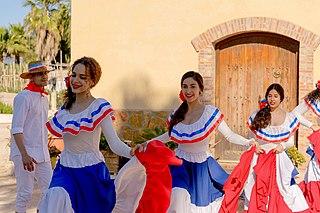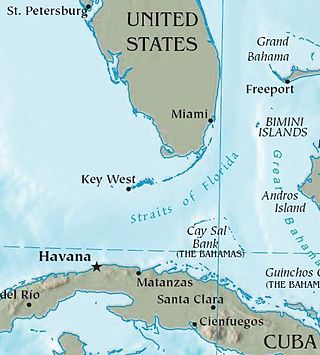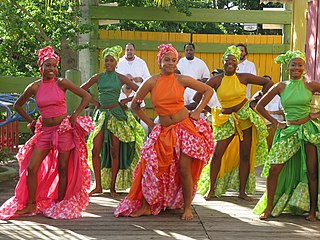
The population of Puerto Rico has been shaped by native American settlement, European colonization especially under the Spanish Empire, slavery and economic migration. Demographic features of the population of Puerto Rico include population density, ethnicity, education of the populace, health of the populace, economic status, religious affiliations and other aspects of the population.

The music of the Dominican Republic is primarily influenced by Western European music, with Sub-Saharan African and native Taino influences. The Dominican Republic is mainly known for its merengue and bachata music, both of which are the most famous styles of music in the Dominican Republic, and have been exported and popularized around the world.

The Music of Puerto Rico has evolved as a heterogeneous and dynamic product of diverse cultural resources. The most conspicuous musical sources of Puerto Rico have primarily included African, Taino Indigenous, and European influences. Puerto Rican music culture today comprises a wide and rich variety of genres, ranging from essentially native genres such as bomba, jíbaro, seis, danza, and plena to more recent hybrid genres such as salsa, Latin trap and reggaeton. Broadly conceived, the realm of "Puerto Rican music" should naturally comprise the music culture of the millions of people of Puerto Rican descent who have lived in the United States, especially in New York City. Their music, from salsa to the boleros of Rafael Hernández, cannot be separated from the music culture of Puerto Rico itself.

Dominicans are an ethno-national people, a people of shared ancestry and culture, who have ancestral roots in the Dominican Republic. The Dominican ethnic group was born out of a fusion of European, native Taino, and African elements, which is an ethnic fusion that goes back to the 16th century. Due to this fusion, the majority of Dominicans are of mixed-race heritage, tracing roots mainly to these three sources with the vast majority being of predominant European ancestry. The demonym Dominican can be traced as far back as the 1621. The name came from Santo Domingo, which was not only the name of the capital city but also of the entire island at the time, Spain used this term to refer to the inhabitants of Spanish colony of Santo Domingo. Recent immigrants and their children, who are legal citizens of the Dominican Republic, can be considered "Dominican" by nationality but not ethnicity due to not having ancestral roots in the country.
Julio Antonio Gervacio is a former boxer and world Super Bantamweight champion from the Dominican Republic.

The wet feet, dry feet policy or wet foot, dry foot policy was the name given to a former interpretation of the 1995 revision of the application of the Cuban Adjustment Act of 1966 that essentially says that anyone who emigrated from Cuba and entered the United States would be allowed to pursue residency a year later. Prior to 1995, the U.S. government allowed all Cubans who reached U.S. territorial waters to remain in the U.S. After talks with the Cuban government, the Clinton administration came to an agreement with Cuba that it would stop admitting people intercepted in U.S. waters.

Corsican immigration to Puerto Rico resulted in the 19th century from widespread economic and political changes in Europe that made life difficult for the peasant and agricultural classes in Corsica and other territories. The Second Industrial Revolution drew more people into urban areas for work, widespread crop failure resulted from long periods of drought, and crop diseases, and political discontent rose. In the early nineteenth century, Spain lost most of its possessions in the so-called "New World" as its colonies won independence. It feared rebellion in its last two Caribbean colonies: Puerto Rico and Cuba. The Spanish Crown had issued the Royal Decree of Graces of 1815 which fostered and encouraged the immigration of European Catholics, even if not of Spanish origin, to its Caribbean colonies.
Isleños are the descendants of Canarian settlers and immigrants to present-day Louisiana, Puerto Rico, Texas, Cuba, the Dominican Republic, Venezuela, and other parts of the Americas. In these places, the name isleño was applied to the Canary Islanders to distinguish them from Spanish mainlanders known as "peninsulars". Formerly used for the general category of people, it now refers to the specific cultural identity of Canary Islanders or their descendants throughout Latin America and in Louisiana, where they are still called isleños. Another name for Canary Islander in English is "Canarian." In Spanish, an alternative is canario or isleño canario.

Dominican Americans are Americans who trace their ancestry to the Dominican Republic. The word may refer to someone born in the United States of Dominican descent or to someone who has migrated to the United States from the Dominican Republic. As of 2021, there were approximately 2.4 million people of Dominican descent in the United States, including both native and foreign-born. They are the second largest Hispanic group in the Northeastern region of the United States after Puerto Ricans, and the fifth-largest Hispanic/Latino group nationwide.

French immigration to Puerto Rico came about as a result of the economic and political situations which occurred in various places such as Louisiana, Saint-Domingue (Haiti) and in Europe.

Afro–Puerto Ricans are Puerto Ricans who are of African descent. The history of Puerto Ricans of African descent begins with free African men, known as libertos, who accompanied the Spanish Conquistadors in the invasion of the island. The Spaniards enslaved the Taínos, many of whom died as a result of new infectious diseases and the Spaniards' oppressive colonization efforts. Spain's royal government needed laborers and began to rely on African slavery to staff their mining and fort-building operations. The Crown authorized importing enslaved West Africans. As a result, the majority of the African peoples who entered Puerto Rico were the result of the Atlantic slave trade, and came from many different cultures and peoples of the African continent.
Cocolo is a term used in the Hispanic Caribbean to refer to Afro-Caribbean migrant descendants. The term originated in the Dominican Republic and is historically used to refer to the Anglophone Caribbean immigrants and their descendants and more rarely, towards those from the Francophone Caribbean. It is mainly used to refer to the migrants in San Pedro de Macorís, Puerto Plata, the Samaná Peninsula, and other Afro-descendants who arrived in the Atlantic coastal areas of the country in the late 1800s and early 1900s. At the time these migrants were culturally distinct from the lighter Dominicans who primarily lived in the northern interior of the country and had a higher degree of colonial European ancestry.

The culture of Puerto Rico is the result of a number of internal and indigenous influences, both past and present. Modern cultural manifestations showcase the island's rich history and help create an identity that is uniquely Puerto Rican - Taíno, Spanish, African, and North American.
Illegal immigration is the migration of people into a country in violation of that country's immigration laws, or the continuous residence in a country without the legal right to. Illegal immigration tends to be financially upward, from poorer to richer countries. Illegal residence in another country creates the risk of detention, deportation, and/or other sanctions.
Pedro Saúl Pérez was a Dominican advocate for the rights of Dominican immigrants and migrants in Puerto Rico. Pérez was the founder and president of the Dominican Committee for Human Rights of Puerto Rico.
Caribbean immigration to New York City has been prevalent since the late 19th and the early 20th centuries. This immigration wave has seen large numbers of people from Jamaica, Haiti, Cuba, Dominican Republic, Antigua and Barbuda, Guyana, and Trinidad and Tobago, among others, come to New York City in the 20th and 21st centuries. Caribbeans are concentrated in the Bronx, from 211th Street to 241st Street and Gun Hill Road. There are also Caribbean communities in Brooklyn, especially in the neighborhoods of Flatbush and Prospect Heights.

Large-scale Chinese immigration to Puerto Rico and the Caribbean began during the 19th century. Chinese immigrants had to face different obstacles that prohibited or restricted their entry in Puerto Rico.
Non-Hispanic cultural diversity in Puerto Rico and the basic foundation of Puerto Rican culture began with the mixture of the Spanish, Taíno and African cultures in the beginning of the 16th century. In the early 19th century, Puerto Rican culture became more diversified with the arrival of hundreds of families from non-Hispanic countries such as Corsica, France, Germany and Ireland. To a lesser extent other settlers came from Lebanon, China, Portugal and Scotland.
White Dominicans are Dominican people of predominant or full European descent. They are 17.8% of the Dominican Republic's population, according to a 2021 survey by the United Nations Population Fund. The majority of white Dominicans have ancestry from the first European settlers to arrive in Hispaniola in 1492 and are descendants of the Spanish and Portuguese who settled in the island during colonial times, as well as the French who settled in the 17th and 18th centuries. Many whites in the Dominican Republic also descend from Italians, Dutchmen, Germans, Hungarians, Scandinavians, Americans and other nationalities who have migrated between the 19th and 20th centuries. About 9.2% of the Dominican population claims a European immigrant background, according to the 2021 Fondo de Población de las Naciones Unidas survey.
The Haitian minority of the Dominican Republic is the largest ethnic minority in the Dominican Republic since the early 20th century.










